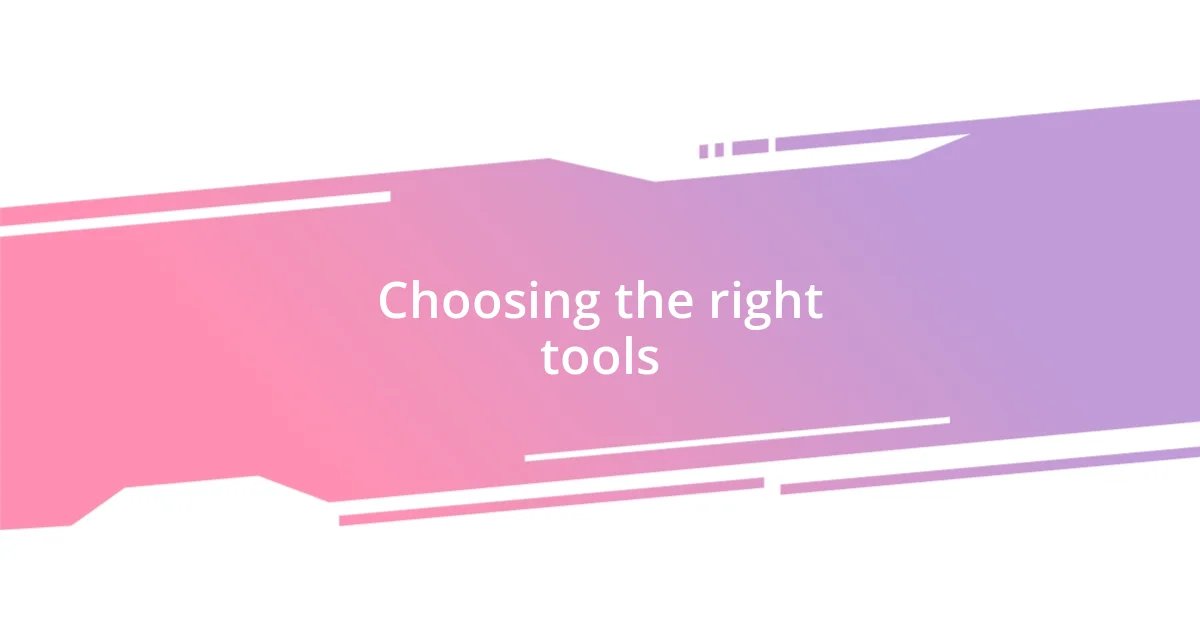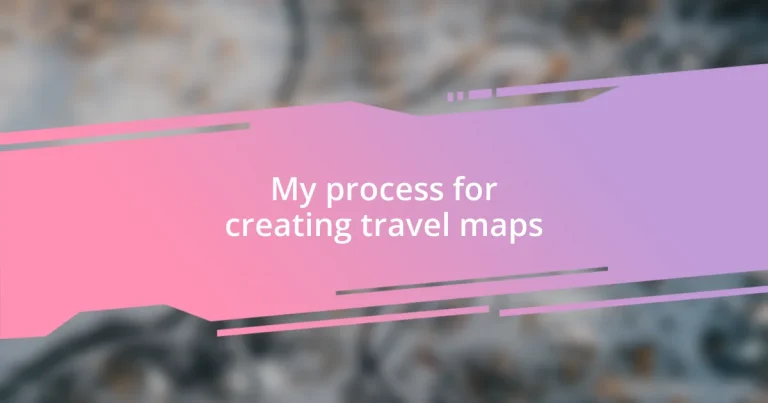Key takeaways:
- Understanding core mapping concepts, like scale and information layering, enhances the narrative and user connection to travel maps.
- Choosing the right mapping tools based on factors such as user-friendliness, customization, and sharing capabilities significantly improves the map creation process.
- Testing and refining maps through real-world application and user feedback ensures clarity, functionality, and a memorable travel experience for users.

Understanding travel mapping concepts
When I first started creating travel maps, I realized that understanding the core elements of mapping is essential. It’s not just about plotting points; it’s about telling a story through visuals. Have you ever looked at a map and felt completely lost despite all the details? That’s often because the map lacks a clear narrative.
The concept of scale is critical in travel mapping, as it impacts how we perceive distances and locations. I remember crafting a map for a road trip, and choosing the right scale made all the difference in planning stops. That realization taught me that the right scale helps users feel a connection to their journey, making each destination more meaningful.
Another key concept is layering information—such as routes, attractions, and personal notes. I often reminisce about my adventures when I incorporate personal markers on my maps. Have you ever embedded your own memories into a map? It turns an ordinary map into a treasure trove of experiences, allowing me to look back and relive those moments each time I glance at it.

Choosing the right tools
Choosing the right tools for creating travel maps can hugely impact your experience and the final product. I remember the first time I used digital mapping software. The intuitive interface made it so much easier to visualize my ideas. By experimenting with various tools, I discovered that some platforms allow for detailed customization, which added a personal touch that made my maps truly unique.
Here are some factors to consider when selecting your mapping tools:
- User-friendliness: Look for software that feels intuitive and straightforward.
- Customization options: The ability to layer information or personalize symbols can transform your map.
- Integration with other platforms: Ensure your chosen tools can connect with other travel planning apps.
- Cost: Some software is free, while others come with a subscription fee. Determine what fits your budget.
- Sharing capabilities: If you want to share your maps with others, check how easily sharing and collaboration works within the tool.
Finding the right mapping tools is like discovering the perfect palette for an artist; it unlocks the potential for creativity and expression.

Collecting essential travel information
Gathering essential travel information is a pivotal step when I begin creating a travel map. I usually start with reliable travel guides and online resources to gather valuable insights about potential destinations. I recall planning a trip to Italy; the information I found about local customs and must-see spots helped shape my journey’s narrative significantly. It’s fascinating how the right information can lead you to hidden gems that aren’t always on the tourist radar.
Another important aspect is utilizing social media platforms. I often browse Instagram for travel inspiration or local experiences shared by fellow travelers. One time, I stumbled upon a post showcasing a quaint restaurant tucked away in a narrow alley in Florence. This firsthand account not only guided my culinary choices but also deepened my understanding of the local culture. Pulling together information from various sources creates a richer travel narrative and allows for more profound connections to the places I visit.
Lastly, I believe in the power of maps created by locals. They provide insights that apps tend to overlook. During a recent trip to Thailand, I used a local map that highlighted serene spots away from the tourist bustle. This experience ultimately enriched my understanding of the culture and environment. Collecting information from diverse sources not only broadens your horizons but also makes your travel maps truly reflective of personal experiences.
| Source | Description |
|---|---|
| Travel Guides | Comprehensive resources that offer detailed insights on destinations. |
| Social Media | Platforms like Instagram provide real-time experiences and unique local recommendations. |
| Local Maps | Maps created by locals often reveal off-the-beaten-path locations and cultural secrets. |

Designing the map layout
Designing the layout of a travel map is where I truly bring my vision to life. I like to start by sketching a rough draft on paper. This allows me to visualize how elements will interact without the pressure of perfectionism. During one of my trips, I sketched a layout while sipping coffee in a cozy café. The simple act of drawing sparked a wave of creativity. It’s amazing how a tactile approach can trigger ideas that digital tools sometimes can’t.
Next, I focus on clarity. I make sure the layout guides the viewer’s eye seamlessly from one destination to another. Choosing symbols and colors that resonate with the locations is also key. For example, on my map of Iceland, I used icy blues for glaciers and vibrant greens for lush areas. This thoughtful color coordination helped convey the emotional tone of the landscape. How often do you find yourself drawn to a map simply because it looks visually appealing? I know I certainly am!
Finally, I consider the balance of information versus space. Sometimes, it’s tempting to cram in as many details as possible, but I’ve learned that less is often more. I recall a map I created for a road trip across the U.S. The pieces I left out—like excessive landmarks and text—actually allowed the important stops to shine through, enhancing the overall experience. Striking that balance ensures the map remains a useful and aesthetically pleasing tool for exploration.

Customizing map for user experience
Customizing a travel map for user experience is an exciting opportunity to tap into personal preferences and interests. I always start by considering what the traveler values most—food, adventure, or relaxation. I remember crafting a map for a friend who loved hiking; I highlighted various trails, complete with difficulty ratings and nearby viewpoints. By tailoring the map to their passions, I ensured they had a satisfying and memorable experience.
Visually, I find that adding interactive elements can significantly enhance user engagement. When I designed a map for a city tour, I incorporated QR codes that linked to local events and market days. I felt a sense of accomplishment when I saw users interacting with the map, discovering events they didn’t initially intend to explore. How great is it when a simple map sparks spontaneous adventures?
To take a more inclusive approach, I’ve learned the value of incorporating accessibility features. A recent project involved creating a map that marked wheelchair-friendly routes in a historic district. Knowing that my efforts contributed to a more enjoyable experience for travelers with mobility challenges gave me a profound sense of purpose. Customizing a map goes beyond aesthetics; it’s about ensuring everyone can create their own beautiful journey.

Testing and refining the map
Once the initial map is created, I dive into the testing phase, where I put my design to the real-world test. I often take the map on a trial run myself, following the route and utilizing my own notes. On a recent weekend getaway, I explored a trail I had mapped out for a friends’ camping trip. It was both exciting and nerve-wracking to see how well the map guided us through winding paths and hidden gems. Finding out that we missed a key viewpoint due to unclear markings reminded me that every detail counts in ensuring a smooth journey.
Refining the map is a crucial part of the process, where I address user feedback. I make it a point to gather insights from others who’ve used the map. I once received a message from a fellow traveler who pointed out that some of the landmarks were overshadowed by the colors I chose. It made me reflect on how perception can differ and how important it is to be open to constructive criticism. Adjusting those hues not only made the landmarks pop but also made the map more user-friendly.
In this iterative journey, I also consider how the map feels to the user. I remember a particularly fulfilling moment when a friend of mine shared photos of their recent trip, emphasizing how the map led them to discover a quaint little café. Knowing that my map contributed to memorable experiences warms my heart. How often does a simple map become a catalyst for unforgettable adventures? Striking the right balance between aesthetic appeal and functional clarity transforms a travel map into a cherished travel companion.














